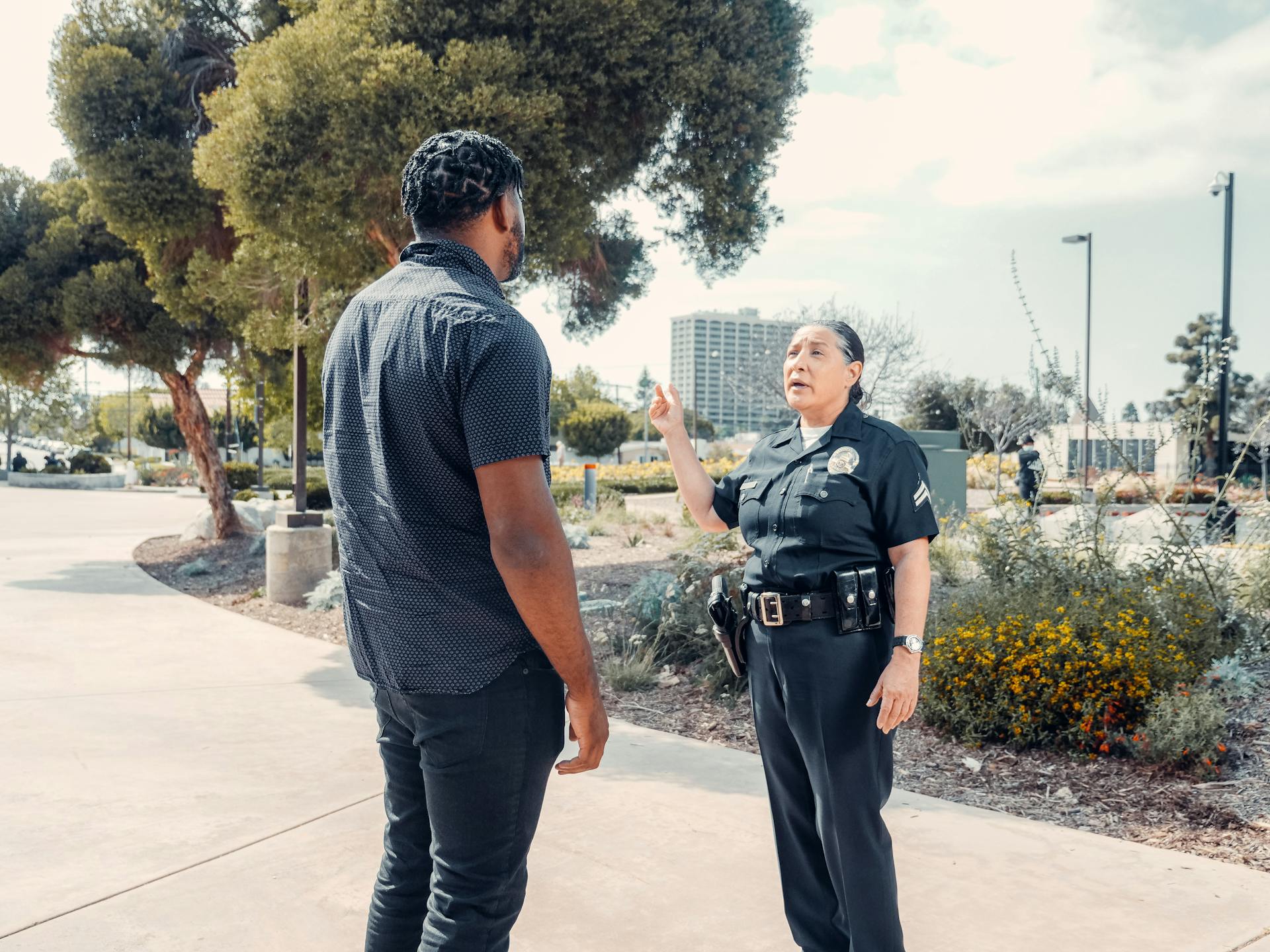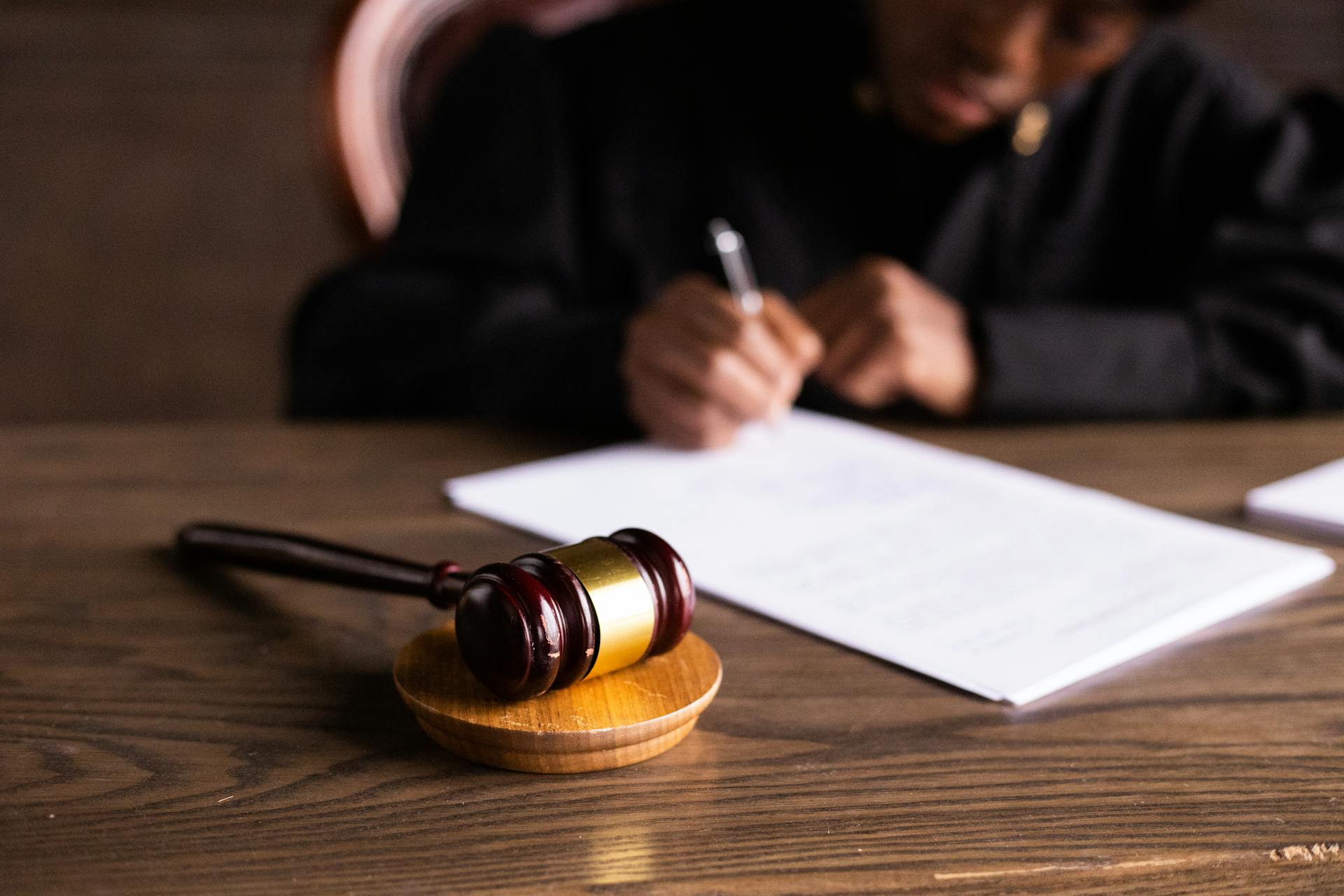
The post judgment collection process can be a complex and time-consuming ordeal. After a judgment is entered, the creditor must take steps to collect the debt.
The first step in post judgment collection is to obtain a writ of execution, which authorizes the sale of the debtor's assets to satisfy the debt. This can include bank accounts, real estate, and personal property.
A creditor can also choose to use a variety of collection methods, such as wage garnishment or liens on the debtor's property. These methods can be effective in collecting the debt, but they must be done in accordance with the law.
The creditor must also be prepared to deal with the debtor's attempts to avoid paying the debt, such as by filing for bankruptcy or hiding assets.
For another approach, see: Judgment Collection California
Collection Methods
A judgment lien is a common post-judgment collection method that allows the creditor to attach the debt to real property owned by the debtor. This prevents the debtor from selling the property without first satisfying the unpaid judgment.
For your interest: Judgment Collection
State law governs the method and duration of judgment liens, and they may need to be renewed before expiration. This can be a lengthy process, taking longer to collect on a debt.
Statutory interest accrues the entire time the debt is unpaid, increasing the debt and acting as a deterrent against purposeful avoidance of the judgment lien.
Writ of Fi Fa
A Writ of Fi Fa is a document issued by the Clerk of Court's Office to record a lien on the judgment debtor's property. It's also the legal instrument by which the sheriff of a county may seize the assets of a judgment debtor.
The cost for a Writ of Fi Fa is $25. This fee is a one-time payment that covers the process of issuing the document.
A Writ of Fi Fa can be used to perfect a lien on any motor vehicles owned by the judgment debtor. To do this, you'll need to send a self-addressed envelope, a check for $1 for each vehicle, and a copy of the Fi Fa to the Georgia Department of Revenue, Motor Vehicles Division.
The address for sending the documents is Department of Revenue, Motor Vehicle Division, P.O. Box 740381, Atlanta, GA 30374-0381.
Here are the steps to follow when requesting a Writ of Fi Fa:
- Send a self-addressed envelope, a check for $1 for each vehicle, and a copy of the Fi Fa to the Georgia Department of Revenue, Motor Vehicles Division.
- Make sure to include all the required information and fees.
- Wait for the documents to be processed and the lien to be perfected.
It's worth noting that a Writ of Fi Fa is a powerful tool for collecting debts, but it's not a magic solution. It requires careful planning and execution to be effective.
Collection Methods
A garnishment is a separate legal action that can be filed against a person or business entity that owes funds to the judgment debtor or is holding funds on their behalf. The cost for filing a garnishment in Liberty County is $106.
Garnishments can be filed against banks, credit unions, employees, and general contractors, among others. The Plaintiff or Judgment holder must notify the Defendant that they have filed a Garnishment against them, as governed by the Official Code of Georgia (O.C.G.A.) Section 18-4-8.
A continuing garnishment is used when the judgment debtor is a wage earner and lasts for 1,095 days. The appropriate sums will be deducted from the judgment debtor's wages on a 30-day recurring basis until the entire judgment amount is collected or until the expiration of 1,095 days from the date of service.

Wage garnishment requires the employer of the debtor to withhold a portion of the judgment debtor's wages each pay period and forward the money to the creditor. The creditor must seek a court order and a judge must approve the garnishment.
No more than 25% of the judgment debtor's disposable wages for a week can be garnished, and wages cannot be garnished if the judgment debtor's disposable wages are less than 30 times the federal minimum hourly wage per week.
Court-Ordered Collection
The IRS has special powers when it comes to collecting tax judgments. They can use a levy to collect a tax judgment, which is a broader power than what's available under the Federal Debt Collection Procedure Act.
The IRS can also use federal tax liens to collect tax judgments, and these liens have special characteristics that don't apply to other types of debt. For example, state exemption statutes don't apply to tax judgments.
A fresh viewpoint: How to Use a Collections Agency
Post-judgment interest on tax judgments accrues at a different rate than non-tax judgment rate, and it's compounded daily. This can add up quickly, making it even more important to pay the judgment as soon as possible.
The IRS can disclose tax returns and return information of tax judgment debtors to the United States Attorney for use in collecting tax judgments. However, this information can't be used to collect non-tax judgments, and it must be kept confidential.
The United States Attorney's Office must use extreme care to ensure that tax returns and return information are only used to collect tax judgments and are not shared beyond the office personnel directly involved in the case.
Tax Division's Role
The Tax Division plays a crucial role in post-judgment collection. They have primary responsibility for collecting judgments after a court has entered a money judgment in favor of the United States.
The Tax Division follows collection steps outlined in the Tax Division Collection Manual, which includes consulting the IRS for further administrative collection if the trial attorney is unable to collect the entire amount of the judgment.
The Tax Division may refer a judgment to the IRS for further administrative collection if the trial attorney is unable to collect the entire amount of the judgment, and the court or the parties terminate the litigation.
If the Tax Division refers a case to a United States Attorney's Office, they will send a letter stating that they have formally referred the judgment collection case, and the United States Attorney's Office will have primary responsibility to take further collection efforts.
Here are the two categories of tax judgment collection cases and the United States Attorney's Office responsibilities:
The Tax Division may withdraw the referral to the United States Attorney's Office and take responsibility for the litigation if it appears that the Government needs to pursue additional litigation to collect the judgment.
United States Attorney's Role
The United States Attorney's Office has different responsibilities when it comes to post-judgment collection cases, depending on whether the Tax Division has formally referred the case or not.
In cases where the Tax Division has formally referred a judgment for collection, the United States Attorney's Office has primary responsibility for taking further collection efforts and protecting the Government's interests.
The Tax Division may concurrently request the IRS Advisory Services to advise the United States Attorney's Office directly of the existence of potential assets for collection.
If any problems arise, including disagreements between the United States Attorney's Office and the IRS, the United States Attorney's Office should advise the Tax Division, which will then assist in resolving those problems.
The United States Attorney's Office should also advise the Tax Division if it appears that the Government needs to pursue additional litigation to collect the judgment, allowing the Tax Division to withdraw the referral and take responsibility for the litigation.
Here are the two categories of tax judgment collection cases and the United States Attorney's Office responsibilities for each:
In cases where the United States Attorney's Office is assisting the Tax Division in collection, the United States Attorney's Office may have open files and furnish assistance to the Tax Division trial attorney.
Curious to learn more? Check out: Judgment Collection Attorney Colorado
Collection of Tax Judgments
Collection of Tax Judgments is a complex process that requires careful attention to detail. The Tax Division has primary responsibility for collecting tax judgments, and they follow the collection steps outlined in the Tax Division Collection Manual.
The Tax Division will refer the judgment to the IRS for further administrative collection if they're unable to collect the entire amount. This is usually done after the trial attorney has exhausted their collection efforts.
The IRS can use a levy to collect a tax judgment, which is a broader collection procedure than what's available under the Federal Debt Collection Procedure Act. State exemption statutes don't apply to tax judgments.
Post-judgment interest on tax judgments accrues at a different rate than non-tax judgments and is compounded daily. This can significantly impact the amount owed.
The IRS may disclose tax returns and return information of tax judgment debtors to the United States Attorney for use in collecting tax judgments. However, this information must be handled with extreme care and only used for tax judgment collection.
Check this out: M2 Machines Worth Collecting
IRS Advisory Services personnel are trained in collecting taxes and have access to financial data contained in tax returns. Assistant United States Attorneys can request that the IRS verify financial statements submitted by taxpayers in connection with an offer to compromise a judgment.
The local Advisory Services staff can be a valuable resource in judgment collection efforts. They can provide valuable information to help Assistant United States Attorneys collect the judgment.
Additional reading: Cks Financial Collect
Frequently Asked Questions
What is the difference between a judgement and a garnishment?
A judgment is a court order that allows debt collection, while garnishment is a specific tool used to collect debt, such as seizing wages or bank accounts. In other words, a judgment enables garnishment, but they are not the same thing.
How long does a creditor have to collect a debt after judgement?
The time a creditor has to collect a debt after a judgment varies by state, typically ranging from 3 to 6 years, but can be longer depending on the type of debt and jurisdiction. Check your state's specific statute of limitations for more information.
What does case status post-judgment mean?
Post-judgment case status refers to the ongoing issues and modifications that arise after a final court decision has been made. This can include changes to child support, alimony, or timesharing arrangements
Sources
- https://www.lawshelf.com/shortvideoscontentview/post-judgment-collection-methods/
- https://www.libertycountyga.com/166/Post-Judgment-Collection-Procedures
- https://www.justice.gov/jm/jm-6-7000-post-judgment-collection
- https://www.peoples-law.org/collecting-judgment
- https://www.smithdebnamlaw.com/article/alchemists-guide-post-judgment-collections/
Featured Images: pexels.com


